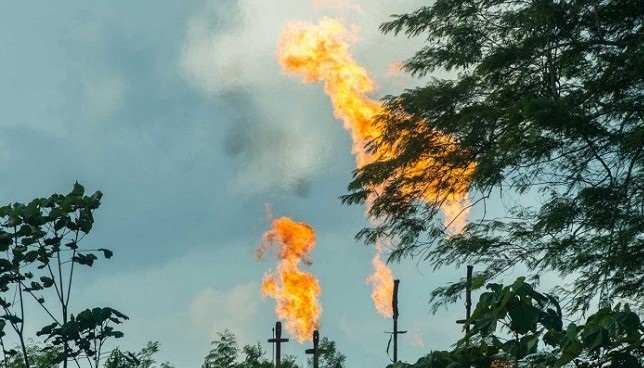An appeals court judge has ruled that the Ecuadorian oil industry’s long-permitted practice of gas flaring – dubbed “flares of death” by local residents – is unconstitutional. The ruling was delivered on Tuesday, January 26, 2021.

Flaring is a practice in which the oil industry burns the byproducts of oil extraction, producing highly polluting methane and other gases, which erupt as a giant flame from a vertical gas pipe just meters from an oil well head.
There are 447 gas flares in the Ecuadorian Amazon, the heart of Indigenous territory. This includes 79 active flares within the Yasuni World Biosphere Reserve, which is deemed the most biodiverse area on Earth. They burn at an average temperature of 400 degrees Celsius 24-hours a day, year-round, and many are located in residential areas with no protection for exposed families.
The plaintiffs in the case – nine children aged between seven and 14 who live in the contaminated lands of Sucumbios in the Ecuadorian Amazon – sued the state-owned oil company, PetroAmazonas, the Ministry of Energy and Non-Renewable Natural Resources, and the Ministry of the Environment in February 2020 to demand the cessation of gas flares in their villages, which contaminate the air and lead to illness, and the outlawing of future permits.
The case builds upon the 26-year legal battle and $9.5 billion claim against oil giant Texaco-Chevron in the same region to demand justice for the “Amazon Chernobyl”, believed to be one of the worst oil-related disasters in the world.
“I am very happy because, finally, justice has been served,” said Leonela Moncayo, one of the child plaintiffs. “We are going to recover nature, for all the sick children, for the parents who have struggled to stay healthy, for the families who live under the flares and have had to abandon their land.”
Gases such as carbon monoxide, carbon dioxide, sulphur oxides, SH2, CS2, nitrogen oxides, methane, ethane, propane, among others, spew out of these flares. Of these, SO2 (sulphur oxide) stands out, which when mixed with water (H2O) can form sulphurous acid (SO3H2) which, according to researchers, has been used for decades as a rat poison.
The toxic pollution caused by flaring is known to lead to chromosomal and genetic damage. The closer one lives to the flares, the more dangerous the conditions are for cancer, malformations and miscarriages.
Two studies conducted in 2016 by researchers on the impacts of the oil industry on the health of Indigenous peoples living near the oil fields found that one in four families had at least one case of cancer. In nationalities further from contamination, the frequency of cancer was three times lower.
The flares also contain sulphuric acid (which is responsible for acid rain), heavy metals, radioactive substances and hydrocarbons. This form of contamination is not only a threat to local communities but can travel for 300km or more. During torrential tropical downpours the flares can go out which means they continue spewing unburnt gas, which has greater environmental toxicity.
In an oral ruling on Tuesday, the appeals court judge accepted the plaintiffs’ appeal, revoking a lower court’s sentence and recognising a violation of constitutionally protected rights to health, a healthy environment, the rights of nature, and environmental principles, such as sustainable development and the state’s obligation to adopt policies and measures to prevent negative environmental impacts.
The decision also recognised a violation of international agreements, specifically the United Nations Framework Convention on Climate Change and non-compliance with the obligations assumed by Ecuador in its national climate change strategy to reduce emitting gases and convert gas into energy.
“The gas flares literally contribute to climate change. Ecuador made a commitment through the Paris Agreement to reduce its emissions,” stated Pablo Farjado, the plaintiffs’ lawyer from the Union of the People Affected by Texaco (UDAPT). “Shutting down gas flaring in the Ecuadorian Amazon would fulfill at least 24% of the government’s climate commitment.”
“We are now demanding all the gas flares to be shut down in the country and for the court to order adequate compensation and reparation measures to affected communities. In addition, safe and viable energy alternatives must be developed”, affirms Maria Espinosa, a lawyer for Amazon Frontlines, one of several organisations supporting the case.
